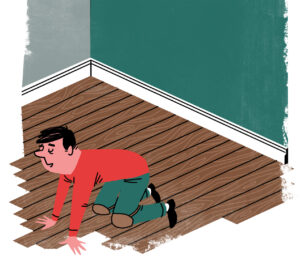The home reno cheat sheet
The secret to projects simple enough to tackle on your own
Advertisement
The secret to projects simple enough to tackle on your own
 If life can be described as an endless cycle of decay and renewal, the same can be said for houses. The decay part happens when the windows start leaking, the doors no longer fit right, the drywall bulges, the carpet disintegrates, the tiles crack, the fence falls down—you get the picture.
The renewal part? That’s you fixing everything broken, tainted, tarnished, outmoded, outdated, or out-of-kilter. The question, as always, is whether to attempt to do the work yourself, or bring in experts to do it for you. It’s a deceptively difficult question to answer, and it’s one you’re going to want to get right.
The first and most obvious reason to tackle your own home renovations is money: you can save thousands of dollars on many home improvement projects by handling the labour yourself. Before you start hammering apart the bathroom tiles or clawing up the carpet, however, there are a few additional things to consider. First off, are you physically up to the challenge? Drywall is heavy; sinking fence posts in solid clay can feel like a labour of Hercules. And you, who sit in a cubicle all day tapping away at a keyboard, are you fit enough for long days in the construction game? You’d better be sure before you pick up that hammer.
Self-knowledge is even more important. Robert Koci, publisher of Canadian Contractor magazine, points to the executive who pulls in $500,000 a year but still does his own home renovations because he enjoys the challenge and change of pace. “There’s something eminently satisfying about working with materials instead of people,” says Koci, who’s spent his life in and around the building trades. “Materials don’t lie. Materials are subject to understandable laws that don’t change. For some people, that’s a welcome diversion from managing people for a living.”
The converse, of course, is that inexperience and a lack of professional-calibre tools can quickly drive one to screaming fits of frustration. “Do-it-yourself challenges who you are and what you’re about,” says Koci. “If you’re impatient, disorganized or easily stressed, DIY might not be for you. If you’re the kind of person who enjoys learning and is intrigued by new experiences, yes, DIY is definitely for you.”
Some jobs, of course, are harder than others. “Start small,” suggests Koci. “Choose projects you think you can handle. Work your way in gently, and build up to bigger, more complex renos.”
And what exactly are these small, easily undertaken DIY renos that can save you big bucks over hiring a contractor? Some of the most common include installing a hardwood floor, trimming a room with baseboard and crown moulding, tiling a bathroom, hanging drywall and building a wooden yard fence. Each involves unique skill sets, tools and materials, as well as cost savings versus hiring a contractor. Best of all, they’re projects a typical homeowner can undertake with limited experience, and still be proud of the results.
If life can be described as an endless cycle of decay and renewal, the same can be said for houses. The decay part happens when the windows start leaking, the doors no longer fit right, the drywall bulges, the carpet disintegrates, the tiles crack, the fence falls down—you get the picture.
The renewal part? That’s you fixing everything broken, tainted, tarnished, outmoded, outdated, or out-of-kilter. The question, as always, is whether to attempt to do the work yourself, or bring in experts to do it for you. It’s a deceptively difficult question to answer, and it’s one you’re going to want to get right.
The first and most obvious reason to tackle your own home renovations is money: you can save thousands of dollars on many home improvement projects by handling the labour yourself. Before you start hammering apart the bathroom tiles or clawing up the carpet, however, there are a few additional things to consider. First off, are you physically up to the challenge? Drywall is heavy; sinking fence posts in solid clay can feel like a labour of Hercules. And you, who sit in a cubicle all day tapping away at a keyboard, are you fit enough for long days in the construction game? You’d better be sure before you pick up that hammer.
Self-knowledge is even more important. Robert Koci, publisher of Canadian Contractor magazine, points to the executive who pulls in $500,000 a year but still does his own home renovations because he enjoys the challenge and change of pace. “There’s something eminently satisfying about working with materials instead of people,” says Koci, who’s spent his life in and around the building trades. “Materials don’t lie. Materials are subject to understandable laws that don’t change. For some people, that’s a welcome diversion from managing people for a living.”
The converse, of course, is that inexperience and a lack of professional-calibre tools can quickly drive one to screaming fits of frustration. “Do-it-yourself challenges who you are and what you’re about,” says Koci. “If you’re impatient, disorganized or easily stressed, DIY might not be for you. If you’re the kind of person who enjoys learning and is intrigued by new experiences, yes, DIY is definitely for you.”
Some jobs, of course, are harder than others. “Start small,” suggests Koci. “Choose projects you think you can handle. Work your way in gently, and build up to bigger, more complex renos.”
And what exactly are these small, easily undertaken DIY renos that can save you big bucks over hiring a contractor? Some of the most common include installing a hardwood floor, trimming a room with baseboard and crown moulding, tiling a bathroom, hanging drywall and building a wooden yard fence. Each involves unique skill sets, tools and materials, as well as cost savings versus hiring a contractor. Best of all, they’re projects a typical homeowner can undertake with limited experience, and still be proud of the results.
 Project 1
Project 1 Project 2
Project 2 Project 5
Project 5Share this article Share on Facebook Share on Twitter Share on Linkedin Share on Reddit Share on Email